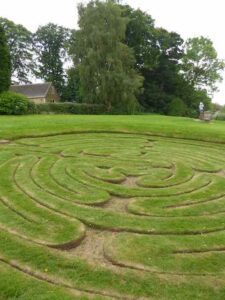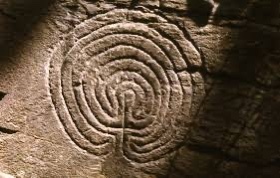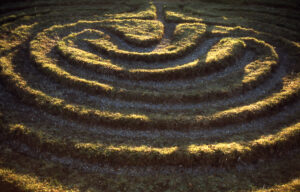All In A Maze: Historic mazes, labyrinths and miz in England
 Julian’s Bower, Alkborough
Julian’s Bower, AlkboroughI’ve been going through my photo resources for The Tarnished Crown trilogy and found this: Julian’s Bower, Alkborough in north Lincolnshire. A turf maze – or properly, labyrinth – or miz of unknown date, it sits on the river cliff overlooking the confluence of the rivers Trent and Ouse and the Humber. It has been variously dated to the Roman period of occupation or as the creation of a small cell of monks in the C13th, but the first known mention of it is not until many hundreds of years later. On the day I visited on a mild June morning, it was eerily quiet and very atmospheric.
Like most similar labyrinths in England and Europe it was created by cutting down through the turf. Weeding and refreshing the edges and the footfall of countless visitors have worn deep trenches. The pattern is familiar: an eleven-circle feature found most often in England and Medieval in design.
 Copy of Julian’s Bower, St Johns, Alkborough
Copy of Julian’s Bower, St Johns, AlkboroughAnd its purpose? Although labyrinths exist in text, picture and form from ancient civilisations, Julian’s Bower is most likely to have been created in the later Medieval period. Like several other surviving examples it is sited near a church. It has been suggested that a small cell of monks in the C13th or before created it as as a penitential or devotional device, praying while shuffling along the narrow maze paths on their knees. The same device is to be found incised into the floor of the nearby church porch, created in the C19th to preserve the pattern of Julian’s Bower should it ever be lost.
It is only one of at least three others known by that name. And in the names given to these miz lies a clue. Walls of Troy, Troy, Troytown, as well as Julian’s Bower possibly refer to Classical tales of Daedaleus, Troy, and the Minotaur all of which were known and referenced in the later Medieval period.The pattern itself is found repeatedly in sculpture, art, in church floors and incised on wooden doors. Examples can be found in obscure places. The stone-cut labyrinth tucked away in Rocky Valley, Cornwall has long been a feature of local tales, although it has been suggested it is not as ancient as it seems.
 Labyrinth petroglyph, Rocky Valley
Labyrinth petroglyph, Rocky ValleyBut dating such things is a tricky business. Many turf miz have become overgrown and lost to time. References to them before the early modern period are rare. A resurgence of interest in the C17th meant that ‘new’ mazes, based on Medieval patterns, were cut. The new bacame confused with the old until they became one and the same in local legends. Myths grew up around them, open to personal interpretation and imagination. Little archaeology survived the contsant recutting and it is down to locating rare antquiarian sketches or researching place names to pinpoint the possible century of origin.
 Turf miz, Wing, Rutland
Turf miz, Wing, RutlandHowever, mazes or daedalus were known to the aristocracy and recorded in literature as a popular pastime. These differed from turf mazes in that they might be made of stone or hedges, have low rails or fences, and were found in the pleasances and great gardens of the nobility for their entertainment.
Turf mazes are more often found in places accessible to the public, near churches and greens, and might have been part of the local tradition of merry-making much as May poles were. Some are now difficult to reach; were they always so or had the village associated with them slipped away into legend and dust?
 ‘City of Troy’, Dalby
‘City of Troy’, DalbyI have no doubt that my protagonist, Isobel Fenton, would have delighted in tracing the convoluted paths of nearby Julian’s Bower. But she, like so many others, would have no certain knowledge of its origin nor its purpose, and the enduring mystery would remain as it does to this day.
The post All In A Maze: Historic mazes, labyrinths and miz in England appeared first on C.F.Dunn.



